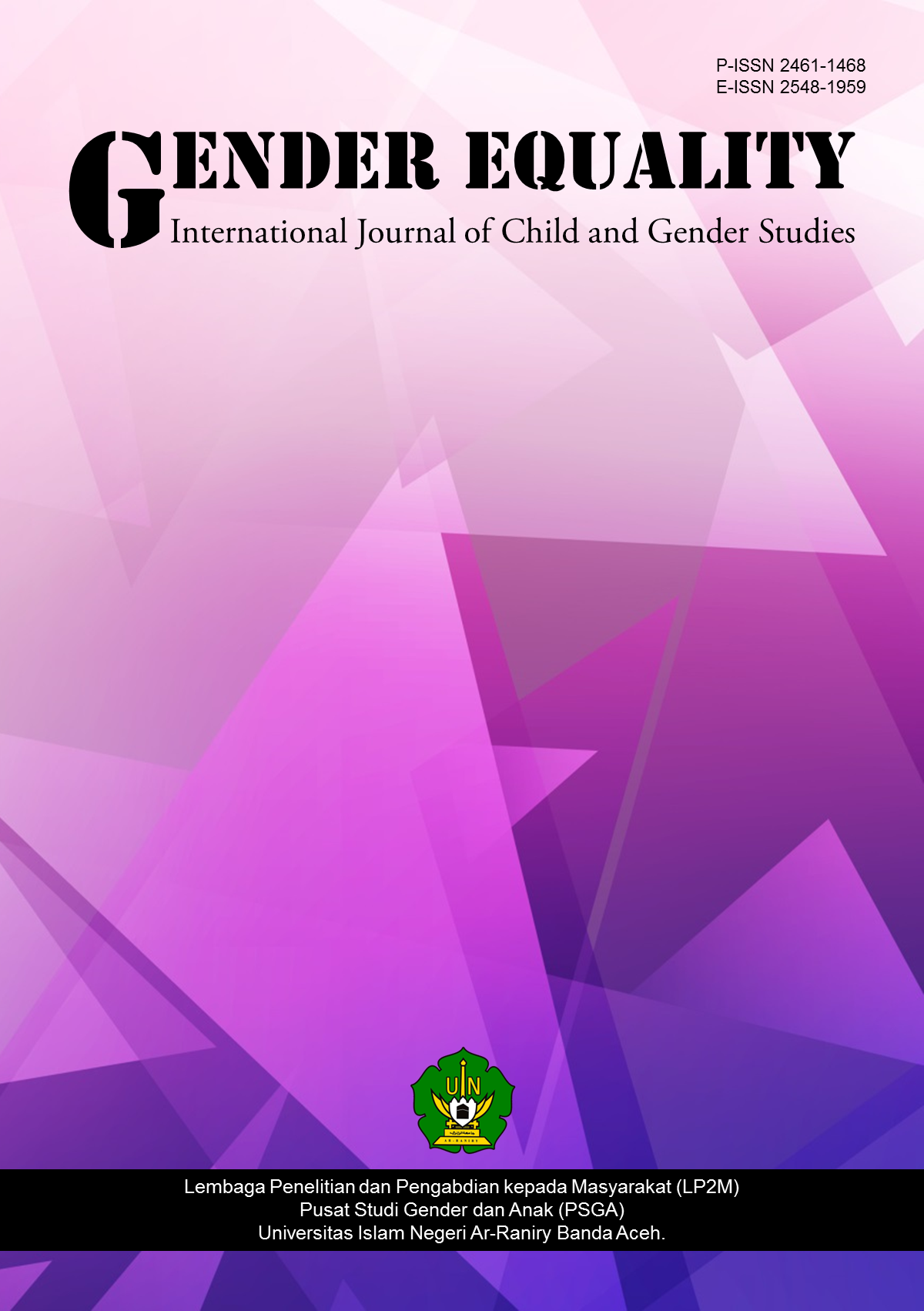PERBEDAAN CITRA TUBUH PADA WANITA MEMILIKI ANAK DAN TIDAK MEMILIKI ANAK
DOI:
https://doi.org/10.22373/equality.v6i2.7921Keywords:
Citra tubuh, wanita memiliki anak, wanita tidak memiliki anakAbstract
Penampilan merupakan hal yang penting bagi wanita. Oleh karena itu, para wanita berupaya untuk tampil sempurna agar dapat menarik perhatian. Penelitian ini bertujuan untuk mengetahui perbedaan citra tubuh pada wanita memiliki anak dan yang tidak memiliki anak. Metode penelitian yang digunakan adalah metode kuantitatif dengan teknik pengambilan sampel incidental sampling. Sampel penelitian berjumlah 60 subjek (30 memiliki anak dan 30 yang tidak memiliki anak). Teknik pengumpulan data menggunakan skala Multidimensional Body Self Relations Questionnaire-Appearance Scale (MBSRQ-AS) yang disusun oleh Cash dan Pruzinsky dengan nilai koefisien reliabilitas penelitian 0,797. Hasil uji analisis Independent Samples T-test menunjukkan bahwa nilai signifikansi (р)=0,877 (р>0,05). Berdasarkan hasil tersebut, maka dapat disimpulkan bahwa tidak terdapat perbedaan citra tubuh pada wanita yang memiliki anak dan tidak memiliki anak.
References
Amalia, L. (2007). Citra tubuh (body image) remaja perempuan. Jurnal Musawa. Vol. 5(4), STAIN Ponorogo
Anna. (2014). Banyak ibu makin gemuk setelah melahirkan. Dalam kompas 17 desember 2014.
Anthony, R. (2009). Rahasia Puncak Percaya Diri Total. Jakarta: Mitra Sejati. Atwater, E. (1999). Psychology of adjustment personal growth in a changing world Prentice Hall New Jersey.
Azwar, S. (2009). Penyusunan Skala Psikologi. Yogyakarta: Pustaka Pelajar. Azwar, S. (2012). Metode penelitian. Yogyakarta: Pustaka pelajar
Azwar, S. (2013). Reliabilitas dan Validitas. Yogyakarta: Pustaka Pelajar.
Barnes, D. L & Balber, L. G. (2007). The Journey to Parentood: Myth, Reality and What Really Matters. United Kingdom : Radcliff Publishng Ltd.
Bestiana, D. (2012). Citra Tubuh dan Konsep Tubuh Ideal Mahasiswa FISIP Universitas Airlangga Surabaya.
Binar, P., Ramadhani., dan Dewi, I.(2014). Perbedaan citra tubuh berdasarkan status gizi remaja putra. E-Journal Univerisitas Diponegoro.
Bonafini, B. A., & Pozzili, P. (2010). Body weight and beauty: the changing face of the ideal female body weight. International Association for the Study of Obesity. 12, 62-65
Brown, Z. & Tiggemann, M. (2016). Attractive celebrity and peer images on Instagram: effect on women’s mood and body image. Body Image 19: 37–43.
Cash, T, F. (2008). The body image work book: an eight step for leaning to your looks (Ed. 2). New Harbinger Publication: United States of America.
Cash, T. F. & Szymanski, M. L. (1995). Body-image disturbances and self-discrepancy theory: expansion of the body-image ideals questionnaire. Old Dominion University.
Cash, T. F. (2000). MBSRQ user’s manual third edition. New York: Old Dominion University.
Cash, T. F., & Pruzinsky, T. (2002). Body image: A handbook of theory, research, and clinical practice. New York: The Guilford Press.
Cash, T. F., & Smolak, L. (2011). Body image : A handbook of science. Practice and prevention (2nd ed). New York : The Guildford Press.
Close & Giles. (2007). Citra Tubuh Pada Remaja Menikah dan Memiliki Anak. Jurnal Psikologi. 1(1) Depok : Universitas Gunadharma.
Cohen, R. & Blaszczynski, A. (2015). Comparative effects of Facebook and conventional media on body image dissatisfaction. Journal of Eating Disorders 3: 23.
Dacey, J., & Kenny, M. (2007). Adolescent development. 2nd edition. USA: Brown & Benchmark Publisher.
Davista, O. A. (2016). Perbedaan body image ditinjau dari tahap perkembangan (remaja dan dewasa awal) dan jenis kelamin (perempuan dan laki-laki) di kelurahan Banyumanik kecamatan Banyumanik kota Semarang. Disertasi. Program Studi Psikologi FPSI- UKSW.
Fardouly, J. & Vartanian, LR. (2016) Social media and body image concerns: current research and future directions. Current Opinion in Psychology 9: 1–5.
Fernando, M. L. (2019). Gambaran citra tubuh pada wanita dewasa awal yang mengalami obesitas. Jurnal Ilmiah Psikologi Terapan, 7(1). 101-118.
Friedman, A., Dixon, K., Brownell, M., Whisman, & D. Wilfler. (1998). “Marital status, marital satisfaction, and body image dissatisfaction,” Int. J. Eat. Disord., vol. 26, pp. 81– 85. Vol. 6, No. 2, September 2020
Gayatri. (2011). Womans guide: Buku cerdas untuk perempuan aktif. Jakarta: Gagasmedia.
Gerson D (2015) These five teens can thank the model who left Instagram for lessons on the dark side of social media. Los Angeles Times.
Gilbert, S., & Thompson, J. (2002). Body shame in childhood & adolescence. In P. Gilbert & J. Miles (Eds), Body Shame (pp.55–74). Hove: Brunner-Routledge.
Goffman, E (2006). The persentation of self in everyday live. Jakarta: Erlangga
Grogan, S. (1999). Citra tubuh: Understanding body dissastifaction in men, woman, and children. London: Routledge.
Downloads
Published
Issue
Section
License
GENDER EQUALITY: International Journal of Child and Gender Studies allows the author(s) to hold the copyright and to retain the publishing rights without restrictions. Authors who publish with this journal agree to the following terms:
- Authors retain copyright and grant the journal right of first publication with the work simultaneously licensed under a Creative Commons Attribution License that allows others to share the work with an acknowledgment of the work's authorship and initial publication in this journal.
- Authors are able to enter into separate, additional contractual arrangements for the non-exclusive distribution of the journal's published version of the work (e.g., post it to an institutional repository or publish it in a book), with an acknowledgment of its initial publication in this journal.
- Authors are permitted and encouraged to post their work online (e.g., in institutional repositories or on their website) prior to and during the submission process, as it can lead to productive exchanges, as well as earlier and greater citation of published work.



